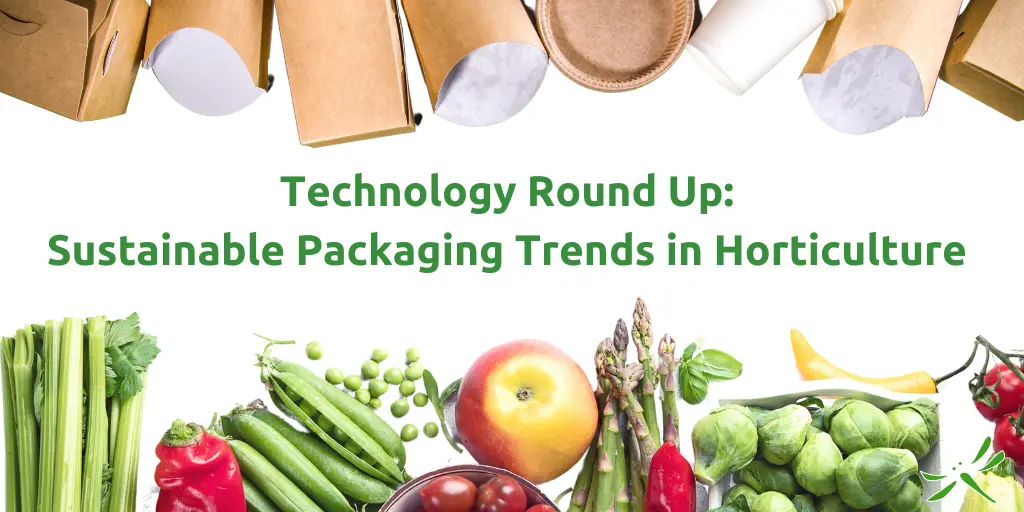Starting fresh in 2025, we are updating our sustainable packing technology round-up. Recent consumer studies suggest that a large percentage of customers are willing to pay more for more sustainable products. This shift in consumer attitude as well as advancements in sustainable packing tech is helping to push the fresh fruit and vegetable industry towards more environmentally friendly options. Previously we have discussed the challenges and benefits of adopting more sustainable packaging options in horticulture. In this article we will get into how the landscape of sustainable packaging has changed to mitigate some of the issues preventing growers and packers from choosing greener packing options and how some of the regulatory changes and requirements impacting the fruit and vegetable industry are shifting.
Big factors impacting packaging decisions for fruits and vegetables
For fresh fruit and vegetable packers and retailers, making decisions about what packaging to use is a complicated balancing act of various factors including traceability & food safety, food waste, environmental impact, and cost of implementation.
Traceability and food safety:
Standards for food packaging cleanliness and material composition are strict for good reason. Ensuring that any new packaging material does not leave harmful residue or create contamination is an important part of assessing new packaging technology. Producers and packers always need to ensure any new packaging supports the labelling and food safety requirements of their commodity. Sustainable packaging must also be able to support the food traceability and nutritional information required.
Food waste:
The efficacy of sustainable packaging is a key consideration as well. A staggering 82 million tons of food is wasted by retail, food service and consumers in North America annually. For some commodities like cucumbers and berries, resistance to moving away from plastic packaging is justified given how much longer their products last in plastic. Any new packaging should not result in a significant reduction in how long a product can last on the shelf.
Environmental impact:
Switching to more sustainable packaging can have major impacts on Scope 3 carbon emissions. Weighing the environmental impact of sustainable packaging options may seem obvious, but the scope of impact of various packaging materials can grow quickly under close examination. Producers need to factor in things like the various recycling and composting capabilities of the regions their products will be consumed and the distance that packaging materials need to travel to reach their pack facilities.
Cost:
Often more sustainable packaging is more expensive than conventional packing materials. Additionally, the cost of implementation of new packing materials and styles needs to be carefully considered. For example - does a compostable sticker or film work with your existing packline or would it require new equipment and calibration in order to use. Consumer polling suggests many customers are willing to pay more for more sustainable products, but there are limits to costs that can be passed on to consumers without losing some markets. Additionally, the cost of not switching may soon outweigh the expense of switching due to the shifting regulations regarding producer responsibility for the eventual disposal of their packaging materials.

Extended Producer Responsibility (EPR) - regulation, recycling, and reporting
Extended Produce Responsibility (EPR) is a policy or strategy that makes the product producer accountable for the full environmental impact of a product's life-cycle, including after it reaches the consumer. In practice this usually means government regulations that enforce more financial responsibility for the environmental impact of the product including disposal, not just the creation. Some levels of EPR programs have been in place for many years in North America and the EU. Bottle and can return programs and tire and battery recycling programs are long standing examples EPR programs.
Mandatory packaging use reporting varies by location and program and usually some exceptions are made for small producers. Many companies and manufacturers have also enrolled in voluntary take back programs. EPR programs in the US and EU already require producers to report on the amount of packaging they send out into the world in order to pay their share of the costs of disposal. The goal is to incentivize companies to use less packaging and to choose packaging that can be composted and easily recycled. Having more materials end up in the landfill results in more money owed.
In Canada, EPR programs are expanding as well. In Ontario for example, producer funded recycling programs are expected to be fully implemented by the end of 2025. Previously municipalities shared costs for recycling programs. Going forward, Ontario recycling programs will be fully funded by producers and managed by Circular Materials. The program will include all materials that end up in a blue (and grey) box including paper/cardboard. According to the Ontario regulations, a company is obligated to register, report on, and pay for packaging material disposal if:
- you are a resident of Canada and brand holder - Ontario growers who pack fruit under their own brand label would fall under this category of producer.
- you import products with no brand holder resident in Canada - Ontario fruit and vegetable packers who import from other countries for packing under their own brand or who resell fall under this category.
- retailers who import products from non Canadian registered brands are responsible for the packing from those products that end up in Ontario.
(Producers with less than 2 million in annual sales are exempt from these reporting requirements currently.)
In order to accurately report on material use, fruit growers and packers will need to maintain records of material use including what the material is, how much in weight has been sent for retail in Ontario and when. Having to work backwards from shipping and sales records is a time consuming and error prone method of tracking material use. Fruit and vegetable growers and packers who use tracking software at the time of field packing, packing and shipping will have a much faster and easier task of consolidating records of material use at reporting time.
6 sustainable packaging technologies for fresh fruits and vegetables
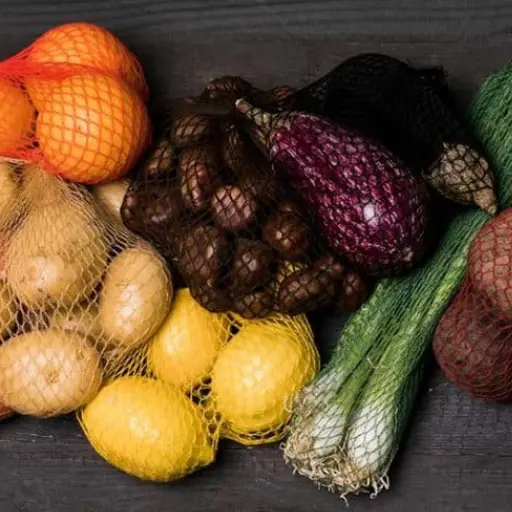
Cellulose biodegradable netting
Net packaging has been a popular packaging material for produce like citrus, onions and garlic. It allows produce to breath and helps avoid humidity, which creates rot. Only recently have there been options to replace the typical plastic netting which is not recyclable in most municipalities. Both PackNatur and Giro offer cellulose netting in a variety of colors that can be composted safely in industrial compost processes.
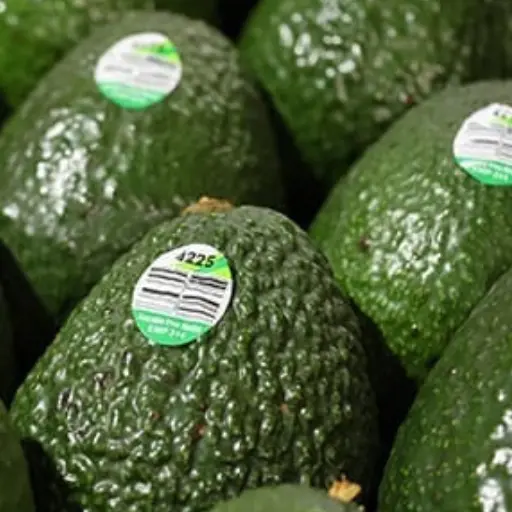
Compostable PLU stickers
One of the most meddlesome contaminants in industrial compost is plastic PLU (Price Look Up) stickers. Plastic contaminants degrade the quality of the compost and contribute to microplastics in the environment. Compostable PLU’s have been a challenge for the fruit and vegetable industry as the stickers need to be able to be applied under damp conditions and need to be compatible with various packlines that apply them. Zespri announced this year that they were partnering with Sinclair International to use compostable stickers exclusively. The CPMA, IFPS, the Canadian Council of Compost and the International Compost Alliance also recently released a joint statement committing to an industry wide study and transition plan to compostable PLU stickers.
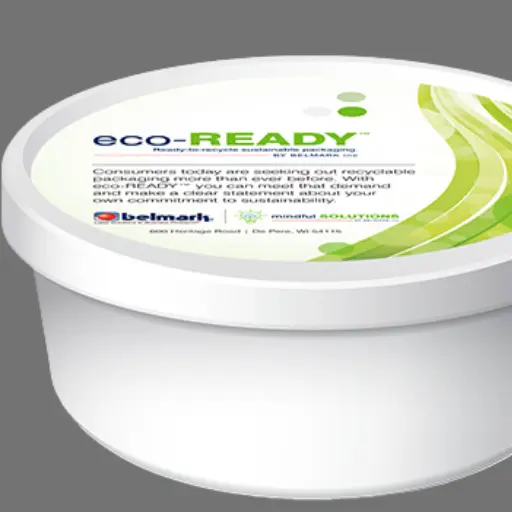
Wash away labels
Ensuring that labelling on plastic can be removed in the recycling process is key to actually being able to recycle the product. Labels typically require heat in the recycling process to be removed, but it is not foolproof. Labels that release with water and can be removed before the item ends up in curbside recycling increases the chances the packaging will be properly recycled. Belmark offers a pressure-sensitive label under their eco-READY™ brand that is easy for consumers or recyclers to remove to properly recycle the plastic.
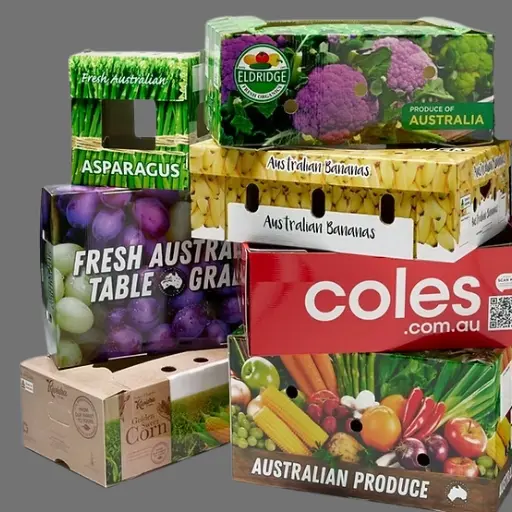
Waterproof cardboard boxes
Produce packaging quite often needs to be able to handle wet, humid and cold conditions without degrading so it can be shipped long distances. Traditionally this means fruits and veggies have to travel in polystyrene (styrofoam) or ‘waxed’ cardboard. While styrofoam packaging is recyclable, it is also a huge source of plastic pollution around the world as it is very light weight and prone to breakage. And unfortunately, the ‘wax’ in waxed cardboard boxes is actually plastic, making it not recyclable in almost all facilities. Disruptive Packaging has developed an innovative solution with its Unicor calcium carbonate enforced cardboard boxes. These waterproof boxes are lighter than traditional waxed cardboard and do not break down like polystyrene. They have also worked with their customers on box exchange programs to ensure closed look recycling, avoiding waste in the supply chain.
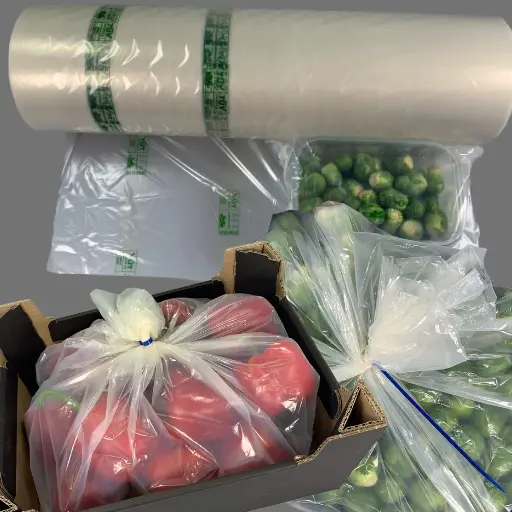
Compostable cling film and bin liners
Sometimes food safety, shipping and storage needs are still best met by plastics. As we highlighted in our previous article, some products, like cucumbers, last significantly longer when wrapped in cling film. While some recycling systems can handle cling film, it needs to be cleaned and separated from other materials before hitting curbside recycling. Having a compostable cling film or plastic bin liner options mean that waste systems can better handle plastics with organic materials as it does not need to be cleaned and isolated before landing in industrial composters. Thankfully more of these products are entering the market. Sinyar biodegradable film comes on industrial rolls so it is compatible with automated packaging lines. Perfotec has recently expanded their line on compostable bin liners which work to extend the storage life of many commodities including broccoli, cherries, cucumbers, mangos, berries and many more.
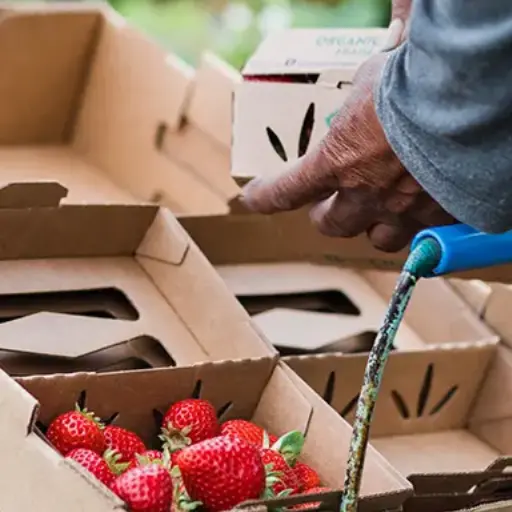
Graphic paper-based packaging
In an effort to eliminate as much single use plastic packaging, many manufacturers and producers are choosing to shift to paper products wherever possible. Paper packaging has many benefits for waste management in produce as it can be easily composted without being cleaned of organic matter. Additionally, paper packaging can have branding and labelling printed right on, meaning the issues of stickers contaminating recycling and composting processes can be avoided. Graphic Packaging International, offers a large range of paper packaging that can be easily customized with eye catching and colourful printing. Sambrailo has expanded their line to include more paper based options for berries and other field packed products. German company Kühling also offers an impressive line of recycled paper berry packaging influenced by their own experience growing berries for generations.
Conclusion: a greener future for horticulture packaging
The horticulture industry stands at the forefront of a pivotal shift toward sustainability. As growers, packers, and retailers navigate the complex interplay of regulatory compliance, environmental stewardship, and consumer expectations, it's clear that sustainable packaging is no longer a luxury but a necessity. Advancements in technology, coupled with evolving consumer attitudes, have unlocked innovative solutions that address long-standing barriers, from food safety concerns to cost-effectiveness.
As we move into 2025, the momentum behind sustainable packaging will only accelerate. With initiatives like Extended Producer Responsibility (EPR) driving reporting and accountability, and new materials such as compostable films, cellulose netting, and waterproof cardboard becoming more accessible, the fresh produce sector is better equipped than ever to meet the challenge. These changes not only contribute to environmental preservation but also reinforce the industry's commitment to quality and responsibility. The journey to fully sustainable packaging is ongoing, but with collaboration, investment, and innovation, the horticulture sector can set an inspiring example for industries worldwide.
